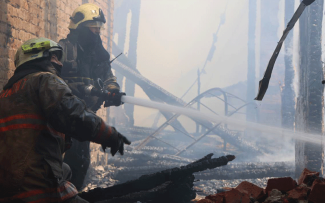‘Shaheds’ hit Ukrainian recruitment centres. Day 1231 of the war

![]()
The Russians have reached the Kazennyi Torets River, and are thus flanking the Pokrovsk-Myrnohrad agglomeration from the north-east. Less than 10 km remains to them from Kramatorsk to the now main supply route for the Ukrainian grouping in the area of the two cities, running there from Kramatorsk. This means that the defenders will most likely be forced to gradually transfer logistics to local routes leading north from Pokrovsk (more than six months earlier they had to abandon supplies via the original main supply route – the M04 highway from Dnipro, 6–8 km from the Russian-occupied positions). Fighting has begun for Novoekonomichne – the last settlement on the route to Myrnohrad from the east.
Russia continues to push Ukrainian forces out of the area north-west of Velyka Novosilka, having taken another four settlements. They have also made progress between it and Pokrovsk on the border with Dnipropetrovsk Oblast. The central part of the built-up area in the southern part of Chasiv Yar came under their control, as well as further positions north-east of Siversk and north of Lyman. In Zaporizhzhia Oblast, they captured most of the village of Kamianske, located on the Dnipro River.
In Kharkiv Oblast, Russian troops expanded their bridgehead on the west bank of the Oskil River. Among other places, they entered Radkivka, which borders Kupiansk from the north. They also crossed the state border in Kharkiv Oblast on a new section (towards Velykyi Burluk and – further – Chuhuiv) and occupied the border town of Milovo (this information is disputed by official Ukrainian sources). At present, there are no signs that the Russians are preparing to develop another strike direction deep into Kharkiv Oblast there. There have been no major developments by either side on the Kursk and Sumy border regions.
The deputy commander-in-chief of the Russian Navy for naval infantry, General Mikhail Gudkov, was killed in Kursk Oblast. This was most likely the result of a precision Ukrainian strike carried out on 2 July against a command post near Korenevo. Until March this year. Gudkov commanded the 155th Marine Brigade (MB) of the Pacific Fleet. He is the first Russian general killed in the frontline zone since December 2024 and the 19th since the start of full-scale aggression to be confirmed dead. According to some sources, the current commander of the 155 MB was killed along with him. It is likely that other officers were also killed and/or wounded.
![]()
On 4 July, Russia carried out a record-breaking air strike against Ukraine in terms of the number of weapons used. According to Ukrainian data, it used 539 strike drones and their imitators and 11 missiles. Kyiv was the main target of this massive attack and, according to a communiqué from the Ukrainian Air Force Command, the air defence failed for the first time to repel the strike: only two missiles were shot down, with the remaining hitting targets in and around the city (previously, the proportions were reversed in attacks on the capital). Kyiv and Kyiv Oblast, as well as the Kirovohrad and Poltava oblasts, were also hit by 63 strike drones, the total number of which – 330 – was also estimated to be a record (the rest were imitators, according to Ukrainian data).
Destruction was reported in six areas of Kyiv, primarily at industrial facilities involved in drone production (including the National Aerospace University) and areas where Patriot system batteries were stationed (mainly in the Zhuliany airport area, where extensive fires occurred, and, according to some sources, also in the vicinity of Boryspil airport). The Academy of the Security Service of Ukraine (SBU), transformer stations (two were destroyed) and railway infrastructure were also targeted, while debris damaged, among others, the building of the consular department of the Polish Embassy. Two were killed and 32 civilians were injured (one of whom died on 8 July). South of the capital, industrial facilities in the Fastov region and Vasylkiv airport were hit. Kyiv was attacked again on 7 July – damage was registered in three areas of the city.
The mobilisation-led territorial recruitment and social assistance centres (in Ukrainian: TCKs, equivalents of military supplementary commands with extended competences) became a new target of Russian strike drones. The centre in Poltava was attacked on 3 July, Kremenchuk on 6 July, and Kryvyi Rih on 7 July (earlier, on 30 June, Kryvyi Rih). The strikes also resulted in civilian casualties: 64 wounded in Poltava, 82 in Kharkiv and 20 in Zaporizhzhia. The Ukrainian Land Forces Command announced that the attacks on the TCKs were intended to delay or even halt mobilisation. It considered the greatest threat to be the destruction – as a result of the fires – of documentation containing data on persons subject to compulsory military service.
The aerial attacks on the replenishment commands are not Russia’s first move by against Ukraine’s mobilisation system. Since at least 2023, TCK headquarters have been subjected to various diversionary activities. Over the past several months, the invaders have also intensified their strikes against training centres, where soldiers receive their initial preparation before being sent to the front.
Ukraine’s logistical and industrial facilities remain a constant target of Russian attacks. Drones and/or ballistic missiles struck Kharkiv and Kramatorsk (2, 6 and 7 July), Sumy (2 and 3 July), Odesa (twice on 3 and once on 7 July), Kryvyi Rih (twice on 4 July), Dnipro and Pavlohrad (4 July), Mykolaiv (twice on 6 and once on 8 July) and Zaporizhzhia (6 July). Russia attacked port infrastructure three times (near Izmail on 2 July, Odesa on 3 July and Mykolaiv on 6 July), and attacked air bases twice (Konotop on 3 July and Starokonstyantynov on 5 July). On 5 July, the Chuhuiv refinery was hit. According to Ukrainian data, from the evening of 1 July until the morning of 8 July, Russia used a total of 38 rockets and 1,339 drones. Ukraine declared three missiles and 669 drones shot down with 444 drones declared locationally lost.
![]()
In the first week of July, the Ukrainians resumed massive drone attacks on Russian territory, with the targets mainly being facilities producing components for drones and missiles. The peak of the strikes occurred on 5 and 6 July, when, according to Russian data, enemy forces used at least 669 drones (the Russians announced the downing of 371 and 298 respectively). Those attacked included. the Saratovorgsintiez refinery in Saratov (2 July), the Kupol electromechanical plant in Izhevsk in Udmurtia and the Energiya electrotechnical plant in Yelets in Lipetsk Oblast (3 July), the mechanical-optical plant in Azov in Rostov Oblast and the mechanical-optical and chemical plant in the town of Sergiev Posad in Moscow Oblast (4 July), WNIIR-Progress electromechanical plant in Cheboksary in Chuvashia and Borisoglebsk airfield in Voronezh Oblast (5 July), the port of Novorossiysk in Krasnodar Krai (6 July, surface drones were also used in the attack), and the chemical plant in Krasnozavodsk in Moscow Oblast and the Ilsky refinery in Krasnodar Krai (7 July). Satellite imagery confirmed the destruction of one of the Kupol plant’s workshop halls. In Sergiev Posad, a power substation was damaged, resulting in a temporary power cut to the town and surrounding areas. According to Ukrainian sources, there was also damage to one of the facilities of the Ilsky refinery.
On 3 July, the Ukrainian media reported that the SBU had eliminated the former ‘mayor’ of occupied Luhansk, Manolis Pilavov. It is thought he was killed in an explosion of a charge planted under a car in the centre of the city. Pilavov was one of the main ideologues of the 2014 ‘Russian Spring’ and a close associate of Ihor Plotnitsky (the so-called leader of the separatist Luhansk People’s Republic) and served as Luhansk’s ‘mayor’ from 2014 to 2023.
![]()
On 3 July, the SBU reported the detention in Lviv Oblast of a major of the Ukrainian Air Force who was alleged to have provided the FSB with, among other things, the geolocation data of air bases, in particular airfields, aircraft servicing facilities and logistics facilities. On 7 July, the SBU captured two FSB collaborators in Zaporizhzhia planning an assassination attempt on soldiers of the 12th brigade of the "Azov" Special Purpose National Guard. The task of the recruits was to plant explosives under cars. In both cases, it is thought that the collaborators were assisted by their wives, who are in the occupied territories and are cooperating with the Russian services.
![]()
On 1 July, the Pentagon halted some arms deliveries to Kyiv (see ‘America First: US halts arms deliveries to Ukraine’). The interruption is said to be of a technical nature, with Ukraine continuing to receive other types of military assistance from the US (primarily intelligence data and satellite support of the reconnaissance, command and communications system). According to Ukrainian sources, the decision affected all types of armaments, including PAC-3 missiles for Patriot air defence systems, 155 mm artillery ammunition, GMLRS missiles for HIMARS systems, Hellfire anti-tank guided missiles, AIM-7 Sparrow and Stinger anti-aircraft missiles and spare parts. From the point of view of the stability of the defence there, the biggest problem is the withholding of missile deliveries for Patriot systems – the only ones that have demonstrated effectiveness against Russia’s ballistic missiles.
On 7 July, President Volodymyr Zelensky stated that Ukraine was working “in particular with the US to find appropriate solutions regarding the Patriots and the missiles for them”. On the same day, the resumption of the delivery of defensive weapons was announced by Donald Trump, with ‘additional’ deliveries notified by the Pentagon. According to the Politico website, this could come after the US-Ukraine talks planned for this week.
Kyiv received a batch of Patria 6×6 wheeled armoured personnel carriers as part of a new military support package from Latvia, the Ukrainian defence ministry announced on 5 July. However, it did not specify the number of vehicles received. On 1 July the government in Riga decided to hand over 42 transporters of this type to the Ukrainians. 133 million euros for ‘new military capabilities for Ukraine’ was set aside by the Swedish government, the Swedish Defence Ministry reported on 3 July. The funds were used, among other things, for ten new barrels for the Archer self-propelled howitzers previously sent to Kyiv.
![]()
On 4 July, Ukraine and Russia carried out an exchange of prisoners of war. This was the eighth since agreements to do so were made during bilateral negotiations in Istanbul in June this year. It involved severely wounded and ill people and those under the age of 25. Their number remains unknown.
![]()
The Russian authorities have set a new record for blocking internet access. According to analysts at the independent Russian service Na Sviazi, 655 local network cut-offs (outages) of varying intensity were recorded in the Russian Federation in June this year alone. This is more than double the number of internet outages worldwide in 2024 (around 300). The surge in mobile internet blockades occurred this spring amid increased Ukrainian drone strikes on Russian territory. The government is seeking to disrupt internet communications to prevent drone operators from navigating and transmitting intelligence.






